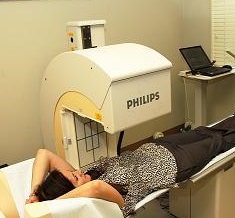What is a Nuclear Heart Scan?
A nuclear heart scan evaluates the heart for coronary artery disease and cardiomyopathy. It may also be used to help determine whether the heart has been damaged by chemotherapy or radiotherapy.
Uses for the Test
Your doctor may recommend a nuclear stress test to:
- Diagnose coronary artery disease.Your coronary arteries are the major blood vessels that supply your heart with blood, oxygen and nutrients. Coronary artery disease develops when these arteries become damaged or diseased — usually due to a buildup of deposits called plaques.
- See the size and shape of your heart.The images from a nuclear stress test can show your doctor if your heart is enlarged and can measure its pumping function (ejection fraction).
- Guide treatment of heart disorders.If you’ve been diagnosed with coronary artery disease, arrhythmia or another heart condition, a nuclear stress test can help your doctor find out how well treatment is working. It may also be used to help establish the right treatment plan for you by determining how much exercise your heart can handle.
How it works?
A nuclear test uses small amounts of radioactive materials called radiotracers that are typically injected into the bloodstream, inhaled, or swallowed. The radiotracer travels through the area being examined and gives off energy in the form of gamma rays which are detected by a special camera and a computer to create images of the inside of your body. Nuclear medicine imaging provides unique information that often cannot be obtained using other imaging procedures.
Follow-up Appointment
During your follow-up appointment, your cardiologist will discuss the results of your nuclear stress test with you. Your results could show:
- Normal blood flow during exercise and rest. You may not need further tests.
- Normal blood flow during rest, but not during exercise. Part of your heart isn’t receiving enough blood when you’re exerting yourself. This may indicate one or more blocked arteries (coronary artery disease).
- Low blood flow during rest and exercise. Part of your heart isn’t getting enough blood at all times. This could be due to severe coronary artery disease or a previous heart attack.
- Lack of radioactive dye in parts of your heart. Areas of your heart that don’t show the radioactive dye have tissue damage from a heart attack.
Without enough blood flow through your heart, you may need to undergo coronary angiography. This is a test to look directly at the blood vessels supplying your heart. If you have severe blockages, you may need a coronary intervention (balloon angioplasty and stent placement) or open-heart surgery (coronary artery bypass).
If you or a loved one has symptoms that might indicate coronary artery diseases, such as shortness of breath or chest pains, please contact us today at 904.222.6657 to schedule a consultation.
